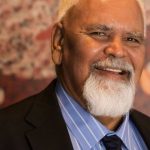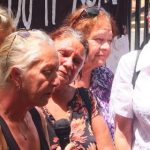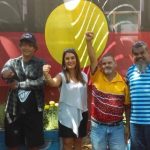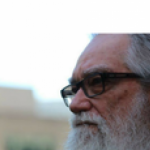Stop the Intervention: An Interview with Indigenous Social Justice Association’s Ken Canning
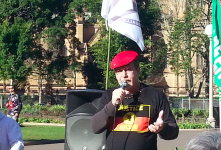
Ten years ago, the Howard government sent the army into 73 remote Aboriginal communities in the Northern Territory. It was a move many described as an act of war.
Officially known as the ‘Northern Territory National Emergency Response’, the intervention was implemented after media reports of paedophile rings operating in communities in Central Australia. The reports were subsequently proven to be false.
This federal government policy – forced upon local Aboriginal people with absolutely no consultation – continues to the present day.
On the back of false claims
In June 2006, the ABC’s Lateline ran a story on alleged paedophile rings operating in Mutitjulu: a remote Aboriginal community east of Uluru.
The key witness making the allegations was supposed to be a former Mutitjulu youth worker, but it was later revealed he was actually an assistant secretary in the Office of Indigenous Policy Coordination, and an advisor to then-Indigenous affairs minister Mal Brough.
The report led to an 18 month, multi-million dollar investigation by the Australian Crime Commission, which found no evidence of organised paedophilia in Northern Territory Aboriginal communities.
The Little Children are Sacred report was released in June 2007. The report –prompted by Lateline – concluded that the federal and state government should work together in consultation with local communities to address child neglect and abuse.
A state of emergency?
On June 21 2007, five days after the release of the report, Howard announced there was a “national emergency” in the NT, and that the government would be taking steps to respond. Just a week later, 600 Australian Defence Force troops were sent into remote communities.
The Northern Territory National Emergency Response Act 2007 was the main bill outlining the legislative package of the Intervention. The legislation suspended the Racial Discrimination Act 1975 in order to allow for the “special measures” that were to be implemented.
These measures included the introduction of the BasicsCard, which quarantined 50 percent of welfare payments, restrictions placed on alcohol, and the abolition of the Community Development Employment Projects, which had been employing many in the communities.
Part 4 of the act also provided for the compulsory acquisition of Aboriginal land by the federal government under five-year leases. A prior right, title or interest to the land was preserved, but the government reversed the right to terminate them at any time by providing written notice to the owner.
Many First Nations leaders simply see the Intervention as a major land grab to make it easier for mining companies to gain access to Aboriginal land.
Ongoing human rights violations
On February 28 2012, the Gillard government passed the Stronger Futures in the Northern Territory Bill 2011, which effectively allowed for the Intervention to be carried on for another decade.
This was despite numerous evaluations revealing that the Intervention had failed. After five years, reported suicide incidents were up 500 percent, school attendance rates had dropped, Indigenous incarceration had increased by 40 percent, and domestic violence had also risen.
Murri activist Ken Canning addressed the Stop the NT Intervention rally held in Sydney’s Hyde Park last Saturday. Sydney Criminal Lawyers® spoke with Mr Canning, chair of the Indigenous Social Justice Association, about the devastation of the Intervention, and the need to bring it to an end.
Firstly, Ken, it’s been ten years since the Intervention began in the Northern Territory. Broadly speaking how would you describe this federal government policy and the effect it’s had?
The policy, in my opinion, is an illegal one. I think the effect it’s had has been a total and utter disaster.
What sort of measures did the Howard government implement under the Intervention?
I never called it an intervention. I called it an act of aggression.
The first thing that Howard did was send the army in. There were people out there that had no idea this was happening, because they had no access to media. So they had no idea they’d called a state of emergency.
The next thing the army has rolled up to 73 different communities and taken them over. It was a sheer act of aggression.
It started off on the wrong platform. It started off with what appeared as a massive land grab.
So that was Operation Outreach, which was launched on June 27 2007. What did the army actually do when they were sent in?
A lot of people actually ran away, which didn’t make the mainstream media. They took off. Eventually, some came back and said, “We thought the country was at war.”
There was all this confusion. But the army did very little when they got there. The soldiers said they didn’t know what they were doing there. They didn’t know why they were sent there. There was no clear-cut reason given to the army of what their jurisdiction was or anything.
They were put there by Howard to effectively secure the communities. And there was no clear indication between the army and the politicians about what was going on.
And what sort of policies did the government implement under the Intervention?
They suspended the Racial Discrimination Act. They were then able to take hold of land.
One of the things they did was the Commonwealth took over the housing co-ops that belonged to the communities. So the Commonwealth had seizure of Aboriginal housing.
Effectively, what they did after that was not a lot of those houses went to Aboriginal people. A lot of them went to non-Aboriginal people, who were the second wave of people that went in there as part of the workforce of the Intervention. The houses were restored and non-Aboriginal families were placed in them.
Their whole notion of housing and fixing up the problem, stage one was an abysmal failure as non-Aboriginal people, who weren’t asked to go there in the first place, were housed there.
So the government implemented strict policies and sent in the army to do so. What was life like – and what has it been like – for the local people actually living on the ground?
I’ve got permission to speak on behalf of the Borroloola community up in the western Gulf area. They said that in the ten years it’s been like a horror film.
There’s been mining companies wanting access to their lands. They’ve had to defend it. They’ve had people running in at 3 o’clock in the morning – not in the last few years, but in the earlier days of the Intervention – putting people on the ground at gunpoint looking like something out of Desert Storm.
This was happening in and around Alice Springs as well.
When Abbott cut $534 million dollars from Aboriginal affairs, he put almost $60 million dollars into the police force in the Northern Territory. And that bought a lot of old gear from the first Iraqi war and they did look like desert stormtroopers running through the joint. They were terrorising people.
One effect that they’re not telling the public is that as we speak 84 percent of the adult population incarcerated are Aboriginal people in the Northern Territory. Ninety four percent of the juvenile population in detention centres are Aboriginal youth. They’re alarming statistics.
We now have the highest teen suicide rate in the whole world.
In the Northern Territory?
Aboriginal people have the highest teen suicide rate on the planet. And that’s because of the massive suicide rates in the Northern Territory and some parts of Western Australia, where they’re removing communities.
According to people on the ground, this has been nothing more than a massive land grab, and a means to get rid of Aboriginal peoples.
The Intervention was said to be in response to the Little Children are Sacred report. Which in turn was a response to the ABC’s Lateline reporting on the supposed paedophile rings in the remote community Mutitjulu.
What do you think about such a drastic policy being implemented by the federal government having been sparked by false media reports?
This comes to the crux of the matter. I’ve been saying this publicly for a long time. I don’t think the ABC has been held accountable, especially Tony Jones – for his role in what happened.
You had Greg Andrews. He went on national TV and stated quite clearly that he was a youth worker, who’d spent 6 months in the Northern Territory and had witnessed adult males engaging in paedophile rings.
The whole fact of the matter is, Tjanara Goreng Goreng who worked with Greg Andrews busted him straightaway. She could tell by his hat and his coat, who he was. He was a Mal Brough staffer, who had not spent a night in Central Australia. Nor was he a youth worker. He was a staffer for the then-minister of Aboriginal affairs.
Tony Jones would have known that. If he didn’t know that, then he would have been the worst journalist in the history of the country.
So he was allowed to go on and tell blatant lies, and straight after that it opened the door for John Howard and he played smoke and mirrors here.
Who was going to oppose John Howard when he says we’ve got to save the children? If anybody opposed it, they would have been seen to be condoning paedophilia.
It was later proven to be completely untrue. And Tony Jones got off scot-free.
In the end the Intervention was delivered in response to the Little Children are Sacred report. However, there was only days between that report coming out and the Howard government putting the policy in place.
Straight after the Intervention, some of the authors of the report said that he twisted the words around for his own means. And that this was not what they were talking about at all.
There was trouble in some communities. And anywhere in the country you will find there are issues of sexual abuse. But in the Northern Territory, after the doctors finished going through the communities, they found very little evidence of sexual abuse.
At the time the Intervention was called, there were more cases of sexual abuse in NSW, than there were in the Northern Territory.
The government initiated the Intervention in June 2007 on that pretext. But by August that year, Howard had changed his tune and said it was more about bringing those people living in remote communities into mainstream Australian society.
In your opinion, Ken, what is the real reason behind the government’s intervention in the Northern Territory?
My opinion has never altered. It was to grab land in the Northern Territory at any cost.
If you look at it historically, prior to the Intervention, Howard was standing over communities trying to get them to sign back their lands. They had freehold title on their lands.
He was trying to get communities to sign it back on 99-year leases. Communities like the Mutitjulu were resisting that. So he was attacking them constantly prior to the Intervention. There were many attacks on these communities.
It was nothing but a massive land grab. And what happened afterwards was a sheer disaster. I can only describe it as genocide by government policy. And it’s not just Howard, because you had the Labor government come in straight after and call it Brighter Futures.
As a matter of fact, when Howard called it, I saw an interview, where Rudd said, “Something had to be done.” And that was the day after it had been called. Rudd didn’t even have a look at the documents, the allegations or anything. He didn’t look at how the process was set up.
And then they came in with Brighter Futures. Well, I don’t think it’s brighter futures, what’s going on there now.
The provisions of the Intervention included the compulsory acquisition of Aboriginal land by the federal government.
Can you tell us a bit about what that actually entailed?
All these 73 communities had freehold title. That just went by the board. They’re now in control of the Commonwealth. Once the Commonwealth has control of those lands, they can do what they want with them.
It’s been the worst kept secret for the last two decades that the mining lobby wanted the Northern Territory lock, stock and barrel.
You have to look at the players, prior, during and what’s going to happen after.
As you’ve already mentioned, in June 2012, the Gilliard government passed the Stronger Futures Bill, which extended the Intervention for another decade.
It was shown the policy wasn’t working. Why did the Labor government see fit to continue it on for another ten years?
It’s not surprising if you look at the history of the Labor movement. It was destroyed in the 80s via Hawke getting into bed with the mining lobby in Western Australia.
After that meeting with three or four mining magnates in WA, the National Land Rights Act went down the gurgler. Something that was agreed to by all stakeholders was destroyed when he met with the mining lobby, who disagreed with it.
There’s nothing new in Labor jumping into bed with the mining lobby.
My only answer to that is, that they’re in on the same act. They want the land. They want to appease their mining buddies. They want the land mined.
If you look at all their other issues, they’re very lukewarm on climate change and clean energy. They’re quite happy to let things go.
Look at things Peter Garrett did when he became the environment minister. He changed the course of the McArthur River that went through the Borroloola community. This is a sacred river that for hundreds of thousands of years has been a ceremonial site for communities all over the Top End.
It’s a sacred place.
It is set in documentation that he refused to meet with them and he changed the course of the river. He also opened the Four Mile uranium mine up near the Kimberleys.
There were a whole lot of acts under the Labor government that indicate that they’re not very interested in hearing from Aboriginal communities. They’re more interested in hearing from the mining lobby.
And lastly, there’s legislation in place to continue on with the Intervention for another five years. Do you think there’s any way around this? What’s the way forward?
The way forward is to scrap it. The way forward in general is to have a nationally elected body that’s a bureaucracy on Aboriginal affairs that would firsthand be a strong advisory body to the government. But then work slowly towards a separation of powers, where we govern our own position and issues.
We’d make the decisions. And the funding wouldn’t be coming from the federal government, but from a one percent tax on all major business in the country.
That is our due right for compensation. We could then run our own programs to make decisions for ourselves.
Self-government for Aboriginal people is the future. And it’s the only way these situations can be solved.
Ken, thanks very much for taking the time out to speak with us today.
That’s okay. Thank you.


